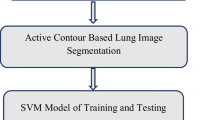Abstract
Purpose
A temporal subtraction (TS) image is obtained by subtracting a previous image, which is warped to match the structures of the previous image and the related current image. The TS technique removes normal structures and enhances interval changes such as new lesions and substitutes in existing abnormalities from a medical image. However, many artifacts remaining on the TS image can be detected as false positives.
Method
This paper presents a novel automatic segmentation of lung nodules using the Watershed method, multiscale gradient vector flow snakes and a detection method using the extracted features and classifiers for small lung nodules (20 mm or less).
Result
Using the proposed method, we conduct an experiment on 30 thoracic multiple-detector computed tomography cases including 31 small lung nodules.
Conclusion
The experimental results indicate the efficiency of our segmentation method.









Similar content being viewed by others
References
Ishida T, Katsuragawa S, Nakamura K, MacMahon H, Doi K (1999) Iterative image warping technique for temporal subtraction of sequential chest radiographs to detect interval change. Med Phys 26(7):1320–1329
Itai Y, Kim H, Ishikawa S, Katsuragawa S, Ishida T, Kawashita I, Awai K, Li Q, Doi K (2006) 3D elastic matching technique for temporal subtraction employing thorax MDCT images. In: World congress on medical physics and biomedical engineering 2006, vol 14, pp 2304–2307
Aoki T, Murakami S, Kim H, Fujii M, Takahashi H, Oki H, Hayashida Y, Katsuragawa S, Shiraishi J, Korogi Y (2014) Temporal subtraction method for lung nodule detection on successive thoracic CT soft-copy images. Radiology 271(1):255–261
Itai Y, Kim H, Ishikawa S (2009) Reduction of FPs for lung nodules in MDCT by use of temporal subtraction with voxel-matching technique. In: 2009 fourth international conference on ICICIC, vol 5506, pp 504–512
Miyake N, Kim H, Itai Y, Tan T, Ishikawa S, Katsuragawa S (2009) Automatic detection of lung nodules in temporal subtraction image by use of shape and density features. Advances in neuro-information processing, pp 1288–1292
Tokisa T, Kim H, Ishikawa S, Tan J, Murakami S, Aoki T (2012) A method for detection of lung nodules from temporal subtraction images. J Biomed Fuzzy Syst Assoc 14(2):23–30 (in Japanese)
Sugiyama A, Kamano S, Yamamoto S, Matsumoto M, Tateno Y, Iinuma T, Matsumoto T (1998) Reduction of false-positive shadows in computer-aided diagnosis system for chest X-ray CT images. Med Imaging Technol 17(3):217–227 (in Japanese)
Tachibana R, Kido S (2006) Automatic segmentation of pulmonary nodules on CT images by use of NCI lung image database consortium. Proc SPIE 6144:61440M
Tang J, Acton S (2004) Vessel boundary tracking for intravital microscopy via multiscale gradient vector flow snakes. IEEE Trans Biomed Eng 51(2):316–324
Ridler T, Calvard S (1978) Picture thresholding using an iterative selection method. IEEE Trans Syst Man Cybern 8(8):630–632
Trussell H (1979) Comments on picture thresholding using an iterative selection method. IEEE Trans Syst Man Cybern 9(5):311
Delogu P, Fantacci M, Kasae P, Retico A (2007) Characterization of mammographic masses using a gradient-base segmentation algorithm and neural classifier. Comput Biol Med 37(10):1479–1491
Sagha H, Dehghani M, Enayati E (2008) Finding sparse features for face detection using genetic algorithms. In: IEEE international conference on computational cybernetics, 2008. ICCC 2008, pp 179–182
Wei J, Hagihara Y, Kobatake H (1999) Detection of cancerous tumors on chest X-ray images—candidate detection filter and its application. In: Proceedings 1999 international conference on image processing, 1999. ICIP 99, vol 3, pp 397–401
Bovik A, Acton S (2000) Basic linear filtering with application to image enhancement. In: Handbook of image and video processing. Academic, New York, pp 71–79
Xu C, Prince J (1998) Generalized gradient vector flow external forces for active contours. Signal Process 71(2):131–139
Acknowledgements
This study was funded by KAKENHI of MEXT-Japan (26108009;16809746).
Author information
Authors and Affiliations
Corresponding author
Ethics declarations
Conflict of interest
The authors declare that they have no conflict of interest.
Ethical standards
All procedures performed in studies involving human participants were in accordance with the ethical standards of the institutional or national research committee and with the 1964 Helsinki Declaration and its later amendments or comparable ethical standards.
Rights and permissions
About this article
Cite this article
Yoshino, Y., Miyajima, T., Lu, H. et al. Automatic classification of lung nodules on MDCT images with the temporal subtraction technique. Int J CARS 12, 1789–1798 (2017). https://doi.org/10.1007/s11548-017-1598-1
Received:
Accepted:
Published:
Issue Date:
DOI: https://doi.org/10.1007/s11548-017-1598-1




